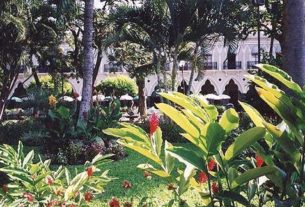Nestled along the southernmost coast of the Gulf of Mexico is the state of Tabasco, birthplace of the Olmecs, called the “mother culture of Mesoamerica”, and the Chontal Maya, famous as seafaring tradesmen.
This impressive heritage, combined with bountiful natural resources, has helped Tabasco preserve significant elements of its ancient cuisine. According to Conaculta’s series on family cooking in Mexico, Tabasco, more than any other state, has kept the original flavor of its traditional dishes by continuing to use pre-Hispanic ingredients and recipes. The refined cooking of the Mayans has remained intact through the centuries since the Chontal presided over the area for the time span between 200 and 1300 AD, during which time they navigated the waterways of continental Mesoamerica, getting as far as the Carribbean and Florida. (During this period of intensive trading, there is evidence of their presence in Cacaxtla, Tlaxcala, where they traded large amounts of their cacao, providing the base for the chocolate drinks imbibed by the ruling class in what is now Central Mexico.) A version of the hand carved cayucas they used along the waterways is still used today by Chontal fishermen.
With 145 miles of coast and more than half of its surface covered by rivers, lagoons and marshes, it is no surprise that a significant part of Tabasco’s regional cooking makes use of freshwater fish and seafood. Pejelagarto, Tabasco famous alligator-head fish, is seasoned with lime juice and chile amashito (a fresh, green jalapeno-like capsicum) and used in everything from tamales to tacos and enchiladas. Most commonly cooked on a grill, pejelagarto is frequently sold in the markets, both raw and cooked, with a long rod or stick running through it, making it easy to place on the grill and turn. Other marine species prominent in Tabasco’s culinary repertoire are mojarra, cazón (baby shark), róbalo (snook) and a variety of shellfish, including shrimp and oysters.
Duck, turkey, iguana, armadillo, tepezcuintle (agouti) and deer are among the sources of animal protein consumed by the pre-Hispanic people of Tabasco and still prepared today in rural areas, although the chicken, beef and pork introduced by the Spaniards in the 16th century are more common in the cities. In fact, Tabasco is one of Mexico’s largest producers of cattle, in addition to raising sugarcane, cacao, coffee, corn, rice, peppers, bananas, coconuts, pineapple, watermelon and a variety of exotic fruit, such as zapote roja (red zapote) and anona (star apple.)
All of this, plus the herbs and spices used in tabasqueña cooking, are found in the famous Pino Suarez market in Tabasco’s capital, Villahermosa. Achiote (annatto) the seed of the bixa orellana tree, is the basis of a regional seasoning paste, and the traditional Mayan herbs, chaya, momo and chipilín are always available.
These herbs are used to flavor the regional tamales, usually filled with pork, pejelagarto, chicken or iguana. The unique tamales called poche consist of pork or other meat mixed with rice and wrapped in momo or hierba santa leaves. Tamales de chaya (the herb sometimes called “Mayan spinach”), tamales de camaron – stuffed with diced shrimp and flavored with chipilín – and chanchamitas de cerdo, pork tamales seasoned with achiote, are local specialties. No self-respecting foodie would visit the Pino Suarez market without tasting at least two or three kinds of tamales.
Other antojitos, or snack foods, in this area of Mexico known for its spices, include empanadas de pejelagarto (fish turnovers) torreja de plátano verde (fried green plantain patties) torta de chaya (chaya, ham and tomato omelet) and yuca en naranja (yucca cooked with garlic and orange juice.)
Los Tulipanes restaurant, in Villahermosa, features a wide array of these antojitos, as well as a selection of guisados, or platos fuertes (main dishes.) Chiclino, shredded baby pig ( lechón) cooked in banana leaves, is served with a red pipian sauce that reflects the Mayan tendency to use seeds in cooking, in this case pumpkin seeds. Other tabasqueña main dishes include estofado de gallina (a rich chicken stew), frijoles negros con carne salada (a black bean and pork dish), robalo a la tabasqueña (snook cooked with Tabascan seasonings) and pollo en chirmol (chicken in a pumpkin seed and chile sauce.) Among the more traditional dishes of the Chontal, whose towns and villages are spread out along waterways, are grilled armadillo, crawfish in ancho chile sauce and crab in red pipian.
To top all this off, the local desserts rely heavily on the abundant tropical fruit. Candied limes filled with coconut; yam- and guava-filled sweet tamales; and a pudding made with a small, wild papaya are among Tabasco’s best-known treats for anyone with a sweet tooth. Oatmeal cake, coconut bars, banana bread and yucca fritters are also popular.
Beverages range from the thick, hot corn drink atole, especially a Pre-Hispanic version called chorote, a corn-and-cacao drink, to balche, a mildly alcoholic drink served ice cold, made from fermented pineapple rind. Aguas are made from guava, pitahaya, pineapple, guarapo (sugar cane juice) and other local fruit. Chocolate is still the king of beverages, often served in the same kind of filigreed gourds depicted on Classic Mayan vases.
The wondrous foliage, wide rivers and several species of tropical birds and waterfowl of Tabasco are worth seeing and its cuisine worth sampling. Even the armchair culinary adventurer might try the following recipes from Tabasco.
- Empanadas de Pescado: Fish Empanadas
- Yuca en Naranja: Yucca in Orange Sauce
- Pollo en Chirmol: Chicken in Tabascan Pipian
- Dulce de Limón: Candied Limes with Coconut Filling

